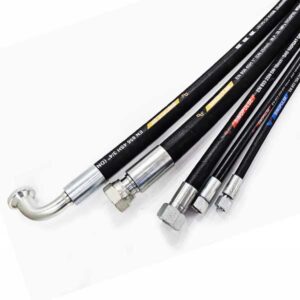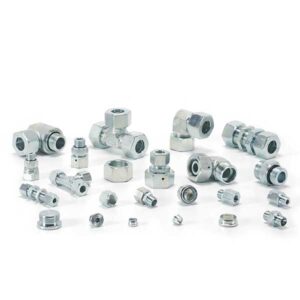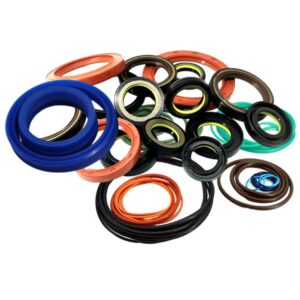The hydraulic system is made up of multiple complicated pieces components that work together to achieve goals. Usually, the goal is to drive the movement pistons or fluids, but hydraulic systems can achieve a variety of different goals. This article will introduce the most basic hydraulic components in the hydraulic system and briefly describe what they do.

हाइड्रॉलिक होस

हाइड्रॉलिक होस are the bridges for fluid flow in hydraulic systems. They can connect pumps, valves, hydraulic cylinders, and many other components.
These hoses are more durable than normal garden hoses because they usually convey fluids with more intense, such as oil, to ensure the normal operation of the system. Despite their hardiness, they still need to be careful handled during installation. All hydraulic hoses have a minimum bend radius; as the name suggests, this is how far a hose can be bent without damaging the inner tube or reinforcement layer. Since fluids always find the path of least resistance, they exert pressure on the hose’s inner sealings, trying to find a way to leak. If the hose is bent too much, the structural integrity of the inner tube and the reinforcement layer will be compromised, and the liquid pressure will pushes too intensely into the bend, potentially causing leakage or burst.
हाइड्रोलिक फिटिंग

The hydraulic fittings is a device used for connecting hydraulic hoses, featuring quick connect and disconnect, excellent sealing performance, pressure resistance, corrosion resistance, and reliability. Its application in hydraulic systems can enhance work efficiency, convenient maintenance and replacement of components, and ensure the safe and stable operation of the system.
Hydraulic quick connect are widely used in industrial equipment, hydraulic machinery, construction machinery, agricultural machinery, ships, and other fields. They can connect hydraulic pipes with hydraulic components such as hydraulic cylinders, hydraulic pumps, and hydraulic motors. Hydraulic quick connect can connect and disconnect quickly, improving the efficiency of system maintenance and component replacement, and reducing downtime.
Seals

Seals are the media or components that prevent oil leakage in hydraulic components and protect the system from dust and dirt. Mechanical seals are devices that help connect systems or mechanisms together by preventing leakage.
When replacing the hydraulic cylinder seals of heavy equipment, choosing the correct type of seal is of great importance. If the seals used are of the wrong size or made of materials that do not meet the requirements, the possibility of leakage will increase, and contaminants may also enter the hydraulic cylinder.
Hydraulic Liquid
The hydraulic system cannot do without liquid! Although water can be used as hydraulic fluid, it is not suitable for various reasons.
The hydraulic system operating temperature can be very high. If exposed to outside in the sun, the temperature will rise further. If the water boils, the hydraulic system will stop working soon. At the same time, just like boiling, you need your liquids to be liquid. If the outdoor freezing, the water freezes, and your system will not be able to work. In the hydraulic system, many are metal components, such as gear pumps, hydraulic cylinders, and so on. Water will accelerate the corrosion of metals, thereby significantly shortening the service life of the system. In some cases, water can be used, but the applicable range is limited. Oil is not as prone to boiling or freezing as water. Oil doesn’t boil or freeze as easily as water. Rather than corrode, the oil lubricates metals. That’s why oils are most commonly used as hydraulic fluids.
Reservoir Tank
The purpose of the reservoir tank is to store hydraulic fluids for the pump to draw from. However, it has several other functions as well. Over time, the hydraulic fluid will be lost over time, so the reservoir tank must excess of fluid to ensure that the system can operate continuously without constant refilling. It also helps cool the fluids, and some systems partially clean it of contaminants.
Hydraulic Pump
The hydraulic pump conveys the hydraulic oil to where it needs to go. It converts mechanical energy into hydraulic energy to achieve specific goals. More specifically, hydraulic energy is the combination of the pressure from the condensed fluid and the flow power given by the pump propelling it.
Pressure gauge sensor
The working principle of the hydraulic pressure sensor mainly relies on the effect of pressure on the sensitive elements inside the sensor, which then generates an electrical signal for output. Specifically, when the pressure in the hydraulic system acts on the diaphragm or sensing element of the sensor, these elements will undergo slight deformation (such as the deformation of the strain gauge, the generation of charge by piezoelectric crystals, or the change in capacitance of the capacitor). This deformation or change will cause changes in the electrical properties of the sensor, such as the resistance value, charge quantity, or capacitance value inside the sensor. Subsequently, these changes in electrical properties are detected and converted by the signal processing circuit into standard analog signals or digital signals, thereby achieving the measurement and monitoring of hydraulic pressure.
Actuator
The hydraulic actuator (also known as the hydraulic cylinder) converts hydraulic energy into mechanical energy. It uses the physical energy from compressing the hydraulic oil to drive its own mechanically. Take a dump truck as an example. The hydraulic fluids is pushed by the pump to the actuator, giving them the energy they need to extend and drop the truck’s payload mechanically.
There are three different kinds of actuators:
Linear Actuators are the truck actuators we mentioned. These actuators move only in a straight line: up and down, or left and right. Rather than moving in a straight line, these Rotary Actuators rotate 360 degrees. Similar to rotary actuators, except they don’t spin in complete rotations. Rotary actuators will turn quickly in one direction, but the semi-rotary variant will rotate left, then switch to right and back.
Valve
We all know what a valve is. We use valves every time we wash our hands in the bathroom. Hydraulic valves control the direction of fluid flow, but in hydraulic systems, there are several different types of control valves available.
Pressure control valve - This valve uses a pressure transducer (PT) to detect the liquid pressure. The pressure transducer sends this information electronically to the valve to indicate when the valve needs to close or open.
Flow control valve - It is very similar to the pressure control valve; the difference is that this valve uses a flow transducer (FT). Similar to the pressure transducer, the flow transducer measures the liquid flow and thereby controls the opening and closing of the valve.
Direction control valve - This is the most unique of the three valves. It allows the operator to control the direction of fluid flow. As we mentioned earlier, when using hydraulic hoses, the liquid flows along the path of least resistance. Without a direction control valve, the liquid will flow in the most convenient direction pushed by the pump.
Filter
Although the reservoir can play a certain role in cleaning, it is the filter that grime out. Engine oil is not the cleanest liquid in the world. It ages and constantly moves around the metal parts, so it is very easy to get dirty. The filter can stop most of the dirt and prevent catching most of it.
Power - Drive (Motor / Engine)
Finally, the power source is one of the most crucial components in the hydraulic system. It is the hydraulic motor. By adding hydraulic oil and turn it on, it powers your system just like any other engine. However, you have another option: install a hydraulic power unit, also known as a hydraulic power unit. This is an one-piece unit that includes the motor, reservoir tank, and pump.
सिनोपुलसे
सिनोपुलसे is leader in hydraulic and industrial hose. Our highly trained experts handle all kinds of hydraulic hose issues every day. If you have problems in hydraulic hoses and components, please संपर्क करें या visit our website for more details.